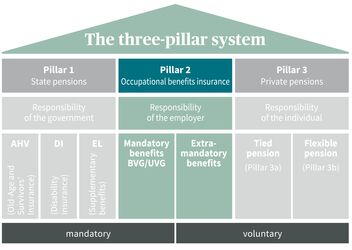Occupational benefits insurance explained in detail.
Mandatory or extra-mandatory? With or without a contribution obligation? Here, you can learn all the details you need to know about mandatory occupational benefits insurance (BVG).
Contribution obligation and organization
All employees with an annual salary subject to AHV contributions which exceeds the BVG minimum annual salary are obliged to pay contributions and to be covered by insurance. Responsibility for correct coverage under occupational benefits insurance rests with the employer. As with AHV contributions, the employer must pay at least half of the contributions for occupational benefits insurance. Incidentally, self-employed persons make voluntary payments into occupational benefits insurance.
The obligation under the Federal Law on Occupational Old Age, Survivors and Disability Pension Plans (OPA) begins when you start gainful employment and ends for men and women when you reach the reference age (formerly: normal retirement age) of 65. Occupational benefits insurance funds are managed by public or private pension funds or occupational benefits institutions.
Salary subject to mandatory and extra-mandatory insurance
A distinction is made between the mandatory and extra-mandatory portions of the insured annual salary on the basis of the BVG. Annual salaries that are subject to AHV contributions and that exceed the BVG minimum annual salary are subject to mandatory insurance. Insured annual salaries that exceed this maximum amount (maximum effective annual salary for BVG purposes) are allocated to the extra-mandatory portion; in this case, the benefits of the pension fund concerned are voluntary. If you want to build up an additional pension above this amount, you should invest in a suitable 3a private pension product.
Amount of benefits and conversion rate
Insured persons generally become entitled to a retirement pension from occupational benefits insurance after they reach the reference age (formerly: normal retirement age). Depending on the regulations of the pension fund or occupational benefits institution, the entitlement can be claimed as from attainment of age 58. The amounts paid out are determined by the available retirement assets and the defined "conversion rate", by which the retirement assets are multiplied. Sample calculation: With a conversion rate of 6.8% and mandatory retirement assets of (for example) CHF 350,000, the annual pension would be CHF 23,800.
It's important to note that the current legal conversion rates may drop in the future. For this reason, it’s a good idea to plan for your retirement early on and starting paying into a Pillar 3 account to ensure you have enough to retire on.
Entitlement to the credit balance
If you change jobs, the accrued BVG retirement assets will be transferred from your current pension fund into your new employer’s fund. In various cases, however, cash disbursement or other ways of using the amount are possible. For instance, the entire BVG credit balance can be paid out in cash if you definitively relocate to another country (except for EU and EFTA countries). Other popular options include advance withdrawal or pledging of the BVG retirement assets to purchase or build a home of your own, or to start out in self-employment. An advance withdrawal of the accrued BVG capital usually gives rise to substantial pension gaps, because the capital to pay out the BVG pension in old age is no longer available. Various products and solutions for private retirement provision are available to address this situation: examples include paying into a Pillar 3a product such as life insurance.
Financing occupational benefits insurance
Like individual retirement accounts, mandatory occupational benefits insurance (OPA) is also fully funded. Each insured person individually saves up for retirement through a legally regulated saving process. As pension funds are required to guarantee all current and future pension payments over the long term, the OPA deductions that are continually paid in are invested as securely as possible, but with the objective of earning returns. The capital market is thus regarded as the "secret" third contributor alongside employers and employees.


